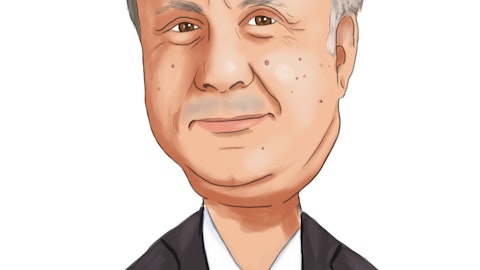Management is very focused on the G&A issue. And our confidence level that we can eventually run Curbline at a G&A level that’s at least as efficient as SITE Centers today is very high. But there’s a transition period, and I think we’ll be giving you a lot more detail in the next few quarters, but I don’t have a lot to add this morning.
Conor Fennerty: Yes, Craig, if you think about — just come back to my comment about projections, we’ve got the NOI ranges. We effectively giving you the pieces for some of the parts. And to David’s point, as we get closer to that spin, they remember we’re still six-plus months off, you’ll start to see us transition more towards the kind of earnings story and giving you the ingredients and pieces. The Form 10 is obviously an important part of that. So again, I think you’ll kind of see a dripping out of information, much like we provide additional information today versus October over the next couple of months.
Craig Mailman: Great. Thank you.
Operator: The next question comes from Todd Thomas with KeyBanc. Please go ahead.
Todd Thomas: Hi, thanks. Good morning. First, can you just expand a little bit on the investment pipeline for Curb Properties in the market today just in terms of product you’re seeing in pricing? And I think, David, you said that you’re emphasizing SITE Centers dispositions today, but I’m curious how we should think of the volume of acquisitions going forward for the Curb entity?
David Lukes : Yes. Todd, there’s a certain amount of angst internally because we’re all excited to be buying assets. We’ve got a lot of opportunities that we’re underwriting. The volume of Curbline assets that are available at any given time in the U.S. is much higher than I would have thought. So it feels like the addressable market is there. We’ve been buying somewhere in the mid-6% cap rate range. We feel strongly about the financial returns of that investment. The challenge is simply one of time management. We’ve got an awful lot of disposition activity going on. Like I mentioned to Craig, the amount of capital that seems to be very intrigued with strip centers, as we turn the calendar to ’24, it’s been high. And so we’ve been allocating internal resources towards dispositions.
And that’s on the legal side, that’s on the transaction side, that’s on the due diligence and underwriting side. And so it has put a little bit of a governor on how much we can allocate to acquisitions. So I would expect the acquisitions to be a little bit slower over the next couple of months because we’re awfully busy on selling.
Todd Thomas: Okay. And you said that Curb is expected to grow, I guess, on the quarter same-store basis around 3% or more over the next several years, but in ’24, is expected to grow 3.5% to 5.5%, so 4.5% at the midpoint. Why is 2024 same-store growth more elevated relative to that long-term growth rate target? Can you just talk about what’s driving that premium growth in the near term for the Curb segment?
David Lukes: Sure.
Conor Fennerty: Hey, Todd, it’s Conor. Good morning. There’s a couple of factors there. The biggest one being simply just the SNO pipeline and the collapse of the kind of lease and occupancy rate. So much like SITE Centers, much like our peers, much like the open-air sector, there’s just been a lot of leasing volume in the Curb portfolio, and we expect that kind of occupancy gap to compress over time. The other member advantage of the Curb portfolio is you just have less downtime. And so if you think about if you got space back over the last couple of years, the downtime to backfill it is a lot shorter versus in anchor. And so you’re just seeing kind of that compression or time line to get those spaces backfilled in a much shorter period, which is driving the growth.
The other thing is we have — remember, it’s a small denominator, some very, very significant mark-to-market opportunities as well. Those are driving as well. So again, I would say it’s a similar boost or drivers versus other kind of open-air real estate. It’s just a tighter time line and a smaller denominator.
Todd Thomas: Okay. That makes sense. And one last one, actually, David. So you’ve mentioned now, I think, twice an increase in appetite for retail real estate since the end of the year, the beginning of the year here. Is the disposition activity still best to be executed on a one-off property basis? Or is there any appetite for portfolio sale or something larger in the marketplace to take place today on the site dispositions?
David Lukes : It remains to be seen, Todd. We’re certainly open-minded the portfolios because it makes our job a little bit easier. And there have been conversations with several groups about potential portfolios. But we’re also price sensitive. And there’s been a lot of private capital that’s got a 1031 need or that knows a submarket and really likes an asset. And in certain cases, it just means that it’s worth the extra work because of the value. I will be curious as well to see a portfolios increase or if we continue more with one-off transactions. I’ll be curious, but I don’t really know.
Todd Thomas: Okay. Thank you.
Operator: The next question comes from Samir Khanal with Evercore ISI. Please go ahead.
Samir Khanal: David, on the $750 million that’s under contract, the power centers of a 7 cap, I mean that may be a positive read for the market out there considering that some people may think it was closer to an 8% kind of what you have remaining to sell. So maybe give us a little bit more color on, I don’t know, like the geographic regions where these assets are located? Is this sort of a portfolio type deal? Or just trying to get a bit more color on these power centers?
David Lukes : Yes. Samir, first of all, just remember I did not say under contract, I said, awarded under LOI or negotiating a contract. So some of those might fall out, they might get replaced by others, but we felt it was important to provide at least some disclosure around how much volume and approximately what type of pricing we’re working on today since it is relevant. I feel like what we’re working on today is fairly consistent with the majority of the portfolio. The assets that we’re currently negotiating contracts are spread across the country. They’re in various retail formats. About 30% of them have a traditional grocery store, about 70% don’t. Some of them are larger assets, some are smaller assets. And so to me, it feels like a pretty good mix of the majority of our portfolio.
I would say there are some assets that we have not transacted yet that are better, i.e., very high-volume grocers. And there are some assets that we — that are not included in that, that’re probably worse. They might have a theater with a high rent. But for the most part, I feel like it’s a pretty consistent read-through to the majority of the portfolio.
Samir Khanal: Okay. Got it. And I guess my second question is around Curbline. I know you’ve said, have no debt initially. But I guess, what’s the longer-term leverage plan or even sort of the capital structure for Curb at this time? Thanks.
Conor Fennerty: Samir, it’s Conor. Good morning. As Dave and I both mentioned, as of today, we’re expecting $300 million of cash at the time to spin and a $300 million preferred investment. However, to David’s point, if we continue to sell assets, that likely shift to just $600 million of cash, and let’s call it, yes, I think we’ve got $1.2 billion or $1.3 billion of GAV today. Now to Todd’s point, we do expect to acquire more assets, let’s call it, $25 million to $50 million a quarter going into it. So round numbers, you’re talking about a GAV of, call it, $1.4 billion and $600 million of cash and perhaps, call it, $2 billion time to spin. Initially, I think it’s fair to assume that Curb would use that cash to deploy capital.
And then once you have utilized that cash, the question is, what’s your kind of leverage path or leverage trajectory? And there, we’ll see how it plays out. I mean I think if you look at our company SITE Centers over the last six years, we’ve generally looked to maintain a balance sheet that was consistent, if not marginally better than the peer group. And I think for curb it’s fair to be seen — fair to see fair to assume, excuse me, that it’s a similar path. All that said, that’s a ways out from now. So we’ll see what we’re — how we go from there. But again, I think it’s fair to assume it’s just a consistent cap structure as we have with SITE today. I don’t know if that helps answer your question.
Samir Khanal: No, it does. That’s it for me. Thanks, guys.
Operator: The next question comes from Floris Van Dijkum with Compass Point. Please go ahead.
Floris Van Dijkum : Hey, good morning, guys. Thanks. It looks like you’re going to be busy for the next couple of months, pretty exciting, new concepts, higher growth, as you say. Just curious on some of the costs involved. You mentioned the commitments that you’ve got for the $1.1 billion of debt, mortgage debt, could you tell us what the cost of that commitment is and what the cost of that debt would be? And then secondly, as part of that, you said that debt is related to 40 assets, I think, post spin. Have you identified those assets already? Presumably, lenders will want to know what assets they’re providing the credit on. And so does that — are those assets some of your better assets or maybe give a little bit of detail on what’s remaining that you expect to be part of SITE’s post spin?
Conor Fennerty: Hey, Floris, good morning. It’s Conor. If you look at our slides on Page 12, we’ve got sources and uses for the transaction, which we updated as of year-end. If you recall, at the time of the spin announced on October 30, we provided a similar slide that was as of the third quarter. So we’ve kind of rolled this quarter to quarter to help with the sources and uses. You are correct to point out that we’ve excluded the commitment fee related to that transaction from those costs. I think it’s fair to assume there’ll be additional details provided in our K, and we filed out in the next couple of weeks from here. But they’re generally market terms. We had a commitment as part of the RVI facility. If you recall back in 2018, I think it closed actually six years ago or six years ago this month, and kind of a market commitment fee is generally around a point upfront and it’s fair to assume that the Apollo facility is something very similar.



